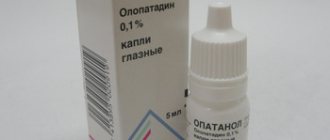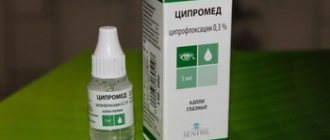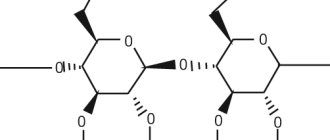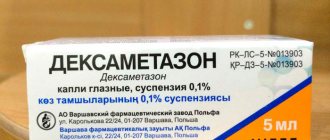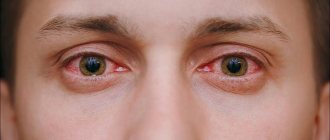Pharmacodynamics and pharmacokinetics
The drug is a local carbonic anhydrase . The mechanism of action is based on inhibition of the secretion of intraocular fluid and slowing down the formation of bicarbonate with a subsequent weakening of the transfer of sodium and water.
The drug does not cause spasm of accommodation, as well as miosis or hemeralopia.
Pharmacokinetic information
- Absorption occurs through the cornea, and also, to a lesser extent, through the sclera and limbus. Systemic absorption rates are low. Once in the blood stream, it quickly penetrates into red blood cells with a significant content of carbonic anhydrase II.
- Binding to plasma proteins occurs by 33%. Converts to an N-desethylated metabolite , which is less active towards carbonic anhydrase II , but is capable of blocking carbonic anhydrase I. Long-term use leads to accumulation in red blood cells.
- Excreted through the kidneys. Withdrawal of the drug has two phases of elimination: fast and subsequent slow, due to the gradual release of the substance from red blood cells.
- Half-life: approximately 4 months.
Mode of application
For proper instillation, it is necessary to move the conjunctival sac and squeeze a drop of the product into each eye. If, as part of mandatory treatment, the doctor has administered several drugs, then when instilling Dorzopt, it is necessary to pause for at least 10 minutes both before and after taking it.
The duration of treatment can be determined by a specialist, based on the patient’s condition, the presence of a negative reaction to the components of the composition, as well as the effectiveness of the drug.
Before deciding to use these eye drops, full monitoring of your heart condition should be ensured. If people have pathologies of the cardiac system, acute or severe chronic diseases, they can be treated with Dorzopt only under the visual supervision of a doctor, preferably in a hospital.
The composition contains the component benzalkonium chloride, which has a predisposition to accumulation in lenses, which after a long period of use of the drug can negatively affect eye cells. Before using the drops, you need to remove the lenses, then put them on no earlier than 20 minutes after instillation.
If a person has diabetes mellitus with the possibility of severe complications, the drug should be used with caution. It contains components that can temporarily relieve the symptoms of hypoglycemia, which significantly complicates its timely detection.
When deciding to undergo surgery, it is necessary to gradually withdraw the drug, completely stopping its use 2 days before the scheduled procedure. If this is not done, the patient may suffer from the action of the anesthetic components of the composition, which will enhance the effect of the drugs used.
| Effect of the drug | Description |
| Impact on optimal control of transport and any other mechanisms | If Dorzopt is used continuously, you should temporarily refrain not only from driving a vehicle, but also from any activities that require increased caution or compliance with mandatory safety precautions. |
| Pregnancy and lactation | There are contraindications to the use of Dorzopt during these periods; there are no exceptions to this rule |
| Liver dysfunction | You can use the drug, but you should be careful, constantly undergoing examinations, so that the components of the composition do not accumulate in the body |
| Kidney disorders | If a severe degree of deficiency or an acute stage of any disease occurs, it is necessary to refrain from using the drug |
| Elderly patients | Use is permitted, but caution should be exercised, and in case of the slightest complications, consult a doctor |
| Children | Prohibited for use by persons under 18 years of age |
This drug is a combination drug, that is, it acts in several directions at once.
In most cases, a course of treatment using such a drug is easily tolerated by patients, but only if there are no obvious contraindications to drugs of this type.
Also, many patients in their reviews of the drug claim that the drug not only normalizes IOP, but also stops the development of degenerative processes in eye tissue, which is typical for glaucoma.
According to the instructions for use, Dorzopt Plus should be instilled no more than once a day at the same time, one drop at a time, but if there are no side effects, the dosage can be increased to two drops.
Sometimes this drug is prescribed not at the beginning of the course of treatment, but as a replacement for other drops that for some reason are not suitable for the patient.
In such situations, the break between the canceled course and the first instillation of Dorzopt Plus should be at least 24 hours.
The drug is used to reduce intraocular pressure in pseudoexfoliative and open-angle forms of glaucoma.
Despite the fact that minor heart problems are not a direct contraindication to the use of the drug, people with such disorders should instill Dorzopt Plus with caution and do this only under the supervision of their attending physician.
Patients who wear contact lenses must remove lenses before each instillation procedure.
Since the preservative benzalkonium chloride contained in the drops tends to settle on inorganic objects, and subsequently the use of lenses on which this substance accumulates can lead to irritation and the development of pathological changes.
If the drug is prescribed to a patient with glaucoma in the preoperative period (to reduce intraocular pressure), instillations must be discontinued at least two days before surgery.
This is due to the fact that drops can enhance the effect of anesthetics administered before surgery.
- dyspnea;
- dizziness;
- interruptions in the functioning of the heart (even to the point of cardiac arrest);
- headache;
- bronchospasms;
- baricardia.
In such situations, you must immediately contact your doctor, who will prescribe supportive and/or symptomatic therapy.
| Number of drops: | Number of instillations: | Duration of treatment: |
| 1–2 depending on the ophthalmologist’s recommendations. | From 1 to 3 times a day. | from 4 weeks and above. |
Dorzopt can be used for a long period of time. But at the same time, it is necessary to monitor the condition of the visual organs, retina, cornea, and regularly measure the level of intraocular pressure.
As for use in childhood, the drug is not prescribed to patients under 18 years of age. Because it is highly toxic. In case of urgent need, an ophthalmologist can prescribe drops, but only after comparing the acceptable harm with the possible benefits of using the drug.
Drops are not prescribed for newborns and children under 3 years of age.
Various medications used together with drops can increase the toxicity of the product:
- Acetylsalicylic acid (in high dosage).
- Other medications aimed at reducing intraocular pressure.
Eye drops with Dorzopt should be carried out only if there are appropriate indications:
- The use of liquid is recommended for open-angle and closed-angle glaucoma.
- The solution is highly effective in the treatment of secondary glaucoma.
- It is widely used for ocular hypertension.
- Dorzopt treats pseudoexfoliative glaucoma.
Before using Dorzopt, the patient must read the instructions. Drops can be used as monotherapy, as well as simultaneously with other ophthalmic solutions.
If monotherapy is carried out, it is recommended to use the solution three times a day. 1 drop of Dorzopt is instilled into each organ of vision.
Some patients are recommended to take Dorzopt and beta-blockers simultaneously. In this case, the solution should be used twice a day.
The break between using solutions should be at least 15 minutes.
Use during pregnancy and children
During the period of bearing a child, female representatives are strictly prohibited from using the solution.
Dorzopt is not recommended for children. It is prescribed only by a doctor after a preliminary examination of a small patient.
Eye drops are used for:
- increased pressure inside the eye, not accompanied by ocular hypertension;
- open-angle glaucoma, both primary and secondary;
- pseudoexfoliative glaucoma.
Glaucoma is a serious eye disease. If left untreated, a person may subsequently lose vision completely.
A clear sign of the presence of a genetic abnormality is hypertelorism.
What constitutes the disease hyphema of the eye is described in detail in the article.
Dorzopt is instilled 1 drop into the affected eye 3 times a day. If, in addition to it, beta-blockers are also used, then it should be dripped no more than 2 times a day.
When treating the eyes with several drugs at once, you must adhere to an interval of 10 minutes between doses.
A single dose of the drug is one drop in each eye. In monotherapy, it is recommended to use the drug three times a day. If the doctor has prescribed a combination type of treatment (adrenoblockers are present in the treatment regimen), then eye drops are used twice a day.
The duration of treatment depends on the specifics of the formation of the pathology, the degree of development of destruction, as well as the individual characteristics of the patient’s body.
Pharmacological tactics are thought through by the attending physician, adjusting the treatment regimen, taking into account therapeutic progress.
The drug should be prescribed with caution to elderly patients.
- Open-angle glaucoma (including secondary);
- Pseudoexfoliative glaucoma;
- Ophthalmic hypertension.
Dorzopt is prescribed locally into the conjunctival sac of the affected eye three times a day, one drop. In combination therapy with topical beta-blockers - drops twice a day.
As we noted above, Dorzopt is an eye drop that is used to treat glaucoma. They are usually classified as carbonic anhydrase inhibitors.
They help reduce increased intraocular pressure without causing pupil constriction, visual disturbances in bright light, or spasm of accommodation.
Release form, composition
The drug Dorzopt is available in the form of colorless transparent eye drops with a concentration of 2%, which are bottled in polymer dropper bottles with a capacity of 5 milliliters. The bottles are packed in cardboard boxes.
The composition of 1 milliliter of eye drops includes:
- 20 milligrams of dorzolamide hydrochloride;
- Mannitol;
- Hyethylosis;
- Citric acid monohydrate;
- Sodium hydroxide;
- Benzalkonium chloride;
- Distilled water.
Dorzopt drops are recommended to be instilled three times a day, one drop at a time, into the conjunctival sac of the affected eye. If the medicine is used in parallel with local beta-blockers, then its dose should be reduced to two times a day, one drop.
Interaction with other drugs
If therapy involves the use of several types of eye drops, then the interval between them should be at least ten minutes. When Dorzopt is used simultaneously with antiglaucoma drugs such as Pilocarpine, Carbachol, Dipivefrin and various beta-blockers, the effect of dorzolamide becomes stronger.
Dorzopt drops are not recommended to be combined with the use of high doses of acetylsalicylic acid, as it increases their toxicity. When Dorzopt is used together with Acetazolamide, the risk of side effects increases.
Indications
The remedy may be prescribed if you have glaucoma (open-angle or pseudoexfoliative).
Permissible dosage and method of administration
Drops should be used to treat patients over 18 years of age. The drug should be instilled into each conjunctival sac, one drop.
The number of instillations per day should be one to two times. It all depends on the severity and severity of glaucoma. The duration of treatment can only be determined by a doctor.
If the patient has been prescribed several medications, the break between doses should be at least ten minutes.
Composition of the product
The package includes a bottle with a dropper. The total volume of the drug does not exceed 5 ml.
The active components of the drug are dorzalamide hydrochloride and timolol maleate. Additional elements include benzalkonium chloride and pure water.
Combination of drugs
An increased hypotensive effect may be observed when taking the drug simultaneously with sympatholytics. Should not be taken simultaneously with MAO inhibitors, analgesics and antiarrhythmic drugs.
When used concomitantly with inhibitors of the CYP2D6 isoenzyme (for example, quinidine), there have been reports of depression and a decrease in heart rate.
The drug is instilled into the affected eye, 1 drop 3 times a day. When used in conjunction with local beta-blockers, the dose is 1 drop 2 times a day.
If several ophthalmic medications are prescribed, they should be instilled into the eyes at least 10 minutes apart.
Treatment with eye drops only on the recommendation of an ophthalmologist in the following cases:
- Open-angle glaucoma.
- Pseudoexfoliative glaucoma.
- For glaucoma.
The instructions for use indicate that Dorzopt Plus is recommended to instill 1 drop into the conjunctival sac of the eye (or both eyes) 2 times a day.
- If the drug is prescribed as a replacement for another ophthalmic drug for the treatment of glaucoma, the latter must be discontinued 1 day before starting therapy with Dorzopt Plus.
- In case of combined use with other local ophthalmic drugs, the drug Dorzopt Plus should be administered at intervals of 10 minutes.
- With nasolacrimal occlusion (closing of the eyelids) for 2 minutes after instillation of the drug, its systemic absorption decreases, which can lead to increased local action.
- Dorzopt Plus is a sterile solution, so patients should be instructed how to use the vial correctly.
The duration of treatment is determined by the doctor depending on the clinical condition of the patient.
According to the instructions for use, when used as part of monotherapy, the drug is instilled three times a day into each eye, one drop.
Sometimes Dorzopt is prescribed together with beta-blockers.
In this case, the frequency of administration is reduced to two times a day, and the interval between instillations of Dorsopt and other drugs should be 10-15 minutes.
This drug is prescribed for open-angle and closed-angle forms of glaucoma.
The medicine is also prescribed for increased intraocular pressure, regardless of the reasons for this disorder.
When treating with Dorzopt, the following features of its use with other agents should be taken into account:
- The effect of the active substance of the drug - dorzolamide - can be enhanced when used together with pilocarpine, carbachol and dipivefrin.
- When taking acetylsalicylic acid in parallel, the toxicity of the drug may increase.
- Systemic side effects may develop if Dorzopt is used simultaneously with acetazolamide.
Dorzopt is prescribed to patients for the treatment of the following conditions:
- Increased intraocular pressure;
- Pseudoexfoliative glaucoma;
- Open angle glaucoma.
Dorzopt eye drops are prescribed only to adult patients. The drug is instilled 1 drop into the conjunctival sac 3 times a day.
If the patient simultaneously uses eye drops from the group of beta-blockers, then Dorzopt is prescribed 1 drop 2 times a day. The interval between instillations of different ophthalmic drugs should be at least 10 minutes.
The duration of the course of treatment should be determined by the ophthalmologist purely individually for each individual patient.
- open-angle glaucoma, including secondary;
- ocular hypertension;
- pseudoexfoliative glaucoma.
According to the instructions, Dorzopt should be instilled 1 drop into the conjunctival sac of the affected eye.
Frequency of application:
- monotherapy – 3 times a day;
- combination with local beta-blockers - 2 times a day.
If therapy involves the use of other local ophthalmic drugs, it is necessary to maintain an interval of 10 minutes between their administration.
Elderly patients may experience an increase in sensitivity to dorzolamide, so they are recommended to use the drug in reduced doses.
Contraindications
- increased or hypersensitivity to the components of eye drops;
- severe renal dysfunction;
- hyperchloremic acidosis;
- age group: under 18 years old;
- lactation period.
Use with caution
- patients with low density of corneal endothelial cells, due to an increased likelihood of corneal edema;
- patients with liver failure ;
- for diabetes mellitus .
Indications
If individual components of the drops are intolerant, local and systemic side effects may occur.
The first include a decrease in eye pressure below normal, an increase in tear production, photophobia, as well as the likelihood of developing inflammatory processes that can affect any tissue of the visual organs.
Dorzopt is characterized by the presence of certain contraindications, which must be taken into account before use:
- If the patient has hypersensitivity to the main or auxiliary components of the drug, then its use is prohibited.
- Dorzopt is not used to treat patients who develop chronic renal failure.
- If the patient's age is less than 18 years, then he should refuse eye drops.
- Dorzopt is contraindicated in women who are breastfeeding newborns.
- Hyperchloremic acidosis may be a contraindication to the use of the drug.
- If the patient is taking other carbonic anhydrase inhibitors orally, then he should avoid Dorzopt.
- After eye surgery, instillation of Dorzopt can only be carried out under the supervision of a physician.
- For photophobia and punctate keratitis, the drug is contraindicated.
- If blepharitis occurs in the patient’s body, then the solution should be discarded.
- It is not used for increased tear production.
- The drug is strictly prohibited for patients with iridocyclitis.
- If there is a significant increase in intraocular pressure, Dorzopt is not prescribed.
Patients who suffer from:
- Diabetes mellitus;
- Liver failure;
- Diseases of the cornea.
The medicine should not be used by women carrying a baby. Children and adolescents under 18 years of age are not allowed to take it. Elderly people should use the drug with caution.
For which diseases should you avoid using the drug:
- Chronic renal failure;
- Hyperchloremic acidosis.
- Asthma.
- Diseases of the cornea.
- Lung damage in chronic or severe form.
- Liver failure.
- Diabetes.
- Acute myocardial infarction.
- Heart failure in the stage of decompensation.
In addition, the drug should not be used by persons who have individual hypersensitivity to the components of Dorzopt, as well as when they are using additional carbonic anhydrase inhibitors orally.
If breastfeeding mothers need to use this medicine, then the baby will need to be switched to formula feeding.
Some pathologies do not allow the free use of Dorzopt in the treatment of glaucoma:
- Individual intolerance to a substance included in ophthalmic eye drops;
- Functional kidney failure;
- Children's age (the drug is not used by patients under 18 years of age);
- Pregnancy;
- Active lactation period;
- Hyperchloremic acidosis;
- Liver failure of various etiologies.
- increased intraocular pressure in open-angle glaucoma and pseudoexfoliative glaucoma with insufficient effectiveness of monotherapy.
- Individual hypersensitivity.
- Kidney failure.
- Hyperchloremic acidosis.
- Oral administration of carbonic anhydrase inhibitors.
- Children under 18 years of age.
- Pregnancy, lactation.
Dorzopt is prescribed with caution in cases of diabetes mellitus, corneal diseases, liver failure, after antiglaucomatous operations (due to the risk of eye hypotony or retinal detachment).
When using Dorzopt Plus drops, patients may experience the following effects:
- Iridocyclitis, burning, keratitis, redness, sensation of the presence of a foreign body in the eye;
- Frequent headaches, increased fatigue, feeling of lethargy;
- Sore throat, dry mouth;
- Tinnitus;
- Pressure surges, fainting;
- Pain in the heart, stomach;
- Peeling of the skin.
In the event of an overdose, the patient may experience increased side effects, as well as depression of kidney, heart and liver function. In isolated cases, the patient may experience cardiac arrest.
If these conditions develop, you should immediately stop taking the drug and go to the hospital. Treatment should be symptomatic. Patients with overdose should closely monitor the functioning of all organs.
Contraindications for use
Serious illnesses are contraindications to prescribing the drug, so you should consult your doctor before starting use. The medicine should not be taken if you have conditions such as:
- Asthma;
- Severe or chronic form of lung damage;
- Changes in heart rhythm;
- Kidney failure, which occurs in severe form;
- Allergy to the components of the medicine;
- Heart failure, which is at the stage of decompensation;
- Cardiogenic shock;
- Changes in the cornea of the eye (degenerative);
- Acute form of myocardial infarction.
The medicine is strictly contraindicated for use in persons under 18 years of age.
In addition, the drug can be prescribed with increased caution to patients of retirement age, with diabetes mellitus, and also with liver failure.
During pregnancy
During this period of time you should stop taking this drug. If there is an urgent need, then taking the drug is allowed, but the girl must regularly see her doctor, take all the necessary tests and undergo examination.
Only if these recommendations are strictly followed can we talk about effective treatment for the mother and safe for the baby.
Dorzopt eye drops are prescribed for open-angle (including secondary) glaucoma, pseudoexfoliative glaucoma, as well as for increased intraocular pressure not accompanied by glaucomatous changes (ophthalmic hypertension).
According to the instructions, the following conditions are contraindications to the use of eye drops:
- The patient's age is under 18 years;
- Cardiogenic shock;
- History of bronchial asthma;
- Acute myocardial infarction;
- Severe renal failure;
- Degenerative changes in the cornea;
- Individual intolerance to the components of the drug;
- Impaired cardiac conduction, changes in heart rhythm;
- Heart failure in the stage of decompensation;
- Severe chronic obstructive pulmonary disease;
- The period of pregnancy and breastfeeding.
Dorzopt plus drops are prescribed with special caution to patients with diabetes mellitus, liver failure or people of retirement age.
Dorzopt should be used only as prescribed by a doctor, since this remedy has an impressive number of contraindications. Among them:
- development of conjunctivitis;
- swelling in the eyelid area;
- thickening of the cornea;
- itching and burning of the conjunctiva;
- manifestation of allergic reactions;
- deterioration in the quality of vision;
- a significant decrease in IOP below normal;
- increased tear production;
- negative impact on retinal tissue, which may peel off after surgery to remove glaucoma;
- punctate keratitis;
- iridocyclitis;
- blepharitis;
- photophobia.
Carefully! Systemic side effects are also possible in the form of dermatological rashes, nausea, aplastic anemia, bitter taste in the mouth, migraines and asthenia.
The medicine has many absolute and relative contraindications:
- age less than 18 years;
- chronic renal failure;
- pregnancy and breastfeeding;
- acidosis, accompanied by an increased level of chlorine in the blood.
Dorzopt is colorless transparent drops, the main active ingredient of which is dorzolamide hydrochloride.
Additional components of the medicine are:
- sodium hydroxide;
- hyethylosis;
- benzalkonium chloride;
- mannitol;
- citric acid in the form of monohydrate;
- purified water.
The drug has serious restrictions on its use, so before starting therapy you should consult an ophthalmologist and carefully study the attached instructions. Eye drops are contraindicated in the following conditions:
- Individual intolerance to the components of the drug;
- Chronic renal failure;
- Age up to 18 years;
- Pregnancy and breastfeeding period;
- Acidosis with increased chlorine levels in the blood;
- Oral use of drugs from the group of carbonic anhydrase inhibitors.
With particular caution, drops can be used in patients with diabetes mellitus, liver failure, after eye surgery, and low intraocular pressure.
Absolute:
- hyperchloremic acidosis;
- chronic renal failure (with creatinine clearance less than 30 ml/min);
- combined use with oral carbonic anhydrase inhibitors;
- age under 18 years;
- pregnancy and lactation;
- individual intolerance to the components of the drug.
Relative (diseases/conditions in which the use of Dorzopt requires caution and medical supervision):
- corneal diseases;
- liver failure;
- diabetes;
- conditions after antiglaucomatous operations (associated with the risk of developing retinal detachment, eye hypotension).
Side effects
Local
- burning and itching in the eye area, swelling of the eyelids, paresthesia , lacrimation, impaired visual clarity, conjunctivitis , blepharitis , superficial punctate keratitis , photophobia ;
- Rare cases of iridocyclitis , allergic reactions, increased corneal thickness, hypotonia , and retinal detachment after AGO ( anti-glaucomatous operations ) are rare.
System
- a feeling of bitterness in the mouth, nausea, development of asthenia , nephrourolithiasis , malignant exudative erythema, migraine, toxic epidermal necrolysis, agranulocytosis , aplastic anemia , skin rashes.
Interaction
- Combination with antiglaucoma drugs ( β-blockers , Pilocarpine , Dipivefrin , Carbachol ) causes an increase in the action of Dorzolamide .
- With Acetazolamide - increased risk of systemic adverse reactions.
- With large doses of Acetylsalicylic acid , increased toxicity is likely.
special instructions
The preservative benzalkonium chloride contained in the drug can be adsorbed by soft contact lenses, causing eye irritation and toxic effects. The drug is used only after removing contact lenses. Contact lenses should be put on no earlier than 15 minutes after instillation.
It is necessary to control the content of potassium, electrolytes in the blood serum and its pH.
Elderly patients may have increased sensitivity to dorzolamide, so this category of patients may require a dose reduction.
Impact on the ability to drive vehicles and operate machinery
During the treatment period, care must be taken when driving vehicles and engaging in other potentially hazardous activities that require increased concentration and speed of psychomotor reactions.
Dorzopt price, where to buy
Average price per eye. Dorzopt drops 2% (5 ml bottle) – 360-370 rubles.
- Online pharmacies in RussiaRussia
- Online pharmacies in UkraineUkraine
ZdravCity
- Dorzopt Plus eye drops 2% 5mlK.O.Rompharm Company S.r.L.
810 rub. order - Dorzopt eye drops 2% 5ml 3 pcs. K.O.Rompharm Company S.r.L.
RUB 1,255 order
Pharmacy Dialogue
- Dorzopt 2% eye drops dropper bottle 5 ml No. 3Rompharma
RUB 1,238 order
- Dorzopt plus eye drops bottle 5mlRompharma
RUR 851 order
- Dorzopt (global drops vial 2% 5ml)Rompharma
RUB 329 order
show more
Pharmacy24
- Dorzoptik 20 mg/ml 5 ml No. 1 eye drops Warsaw FZ, Polfa AT, Poland
153 UAH.order
